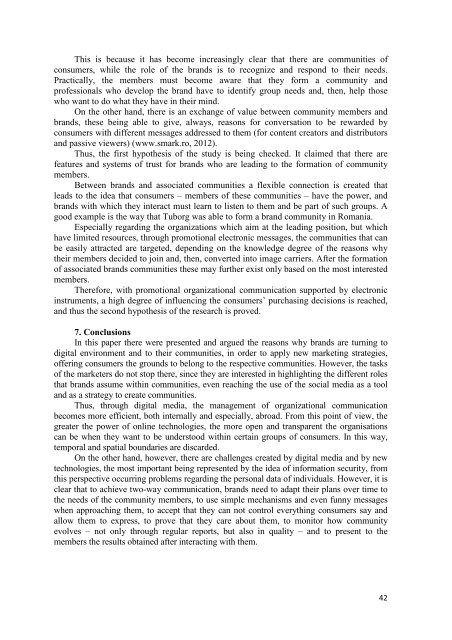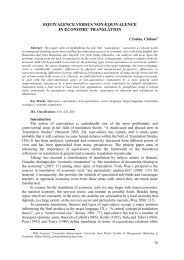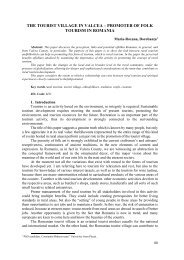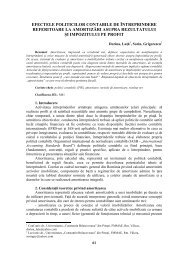Revista PDF - strategiimanageriale.ro
Revista PDF - strategiimanageriale.ro
Revista PDF - strategiimanageriale.ro
You also want an ePaper? Increase the reach of your titles
YUMPU automatically turns print PDFs into web optimized ePapers that Google loves.
This is because it has become increasingly clear that there are communities of<br />
consumers, while the <strong>ro</strong>le of the brands is to recognize and respond to their needs.<br />
Practically, the members must become aware that they form a community and<br />
p<strong>ro</strong>fessionals who develop the brand have to identify g<strong>ro</strong>up needs and, then, help those<br />
who want to do what they have in their mind.<br />
On the other hand, there is an exchange of value between community members and<br />
brands, these being able to give, always, reasons for conversation to be rewarded by<br />
consumers with different messages addressed to them (for content creators and distributors<br />
and passive viewers) (www.smark.<strong>ro</strong>, 2012).<br />
Thus, the first hypothesis of the study is being checked. It claimed that there are<br />
features and systems of trust for brands who are leading to the formation of community<br />
members.<br />
Between brands and associated communities a flexible connection is created that<br />
leads to the idea that consumers – members of these communities – have the power, and<br />
brands with which they interact must learn to listen to them and be part of such g<strong>ro</strong>ups. A<br />
good example is the way that Tuborg was able to form a brand community in Romania.<br />
Especially regarding the organizations which aim at the leading position, but which<br />
have limited resources, th<strong>ro</strong>ugh p<strong>ro</strong>motional elect<strong>ro</strong>nic messages, the communities that can<br />
be easily attracted are targeted, depending on the knowledge degree of the reasons why<br />
their members decided to join and, then, converted into image carriers. After the formation<br />
of associated brands communities these may further exist only based on the most interested<br />
members.<br />
Therefore, with p<strong>ro</strong>motional organizational communication supported by elect<strong>ro</strong>nic<br />
instruments, a high degree of influencing the consumers’ purchasing decisions is reached,<br />
and thus the second hypothesis of the research is p<strong>ro</strong>ved.<br />
7. Conclusions<br />
In this paper there were presented and argued the reasons why brands are turning to<br />
digital envi<strong>ro</strong>nment and to their communities, in order to apply new marketing strategies,<br />
offering consumers the g<strong>ro</strong>unds to belong to the respective communities. However, the tasks<br />
of the marketers do not stop there, since they are interested in highlighting the different <strong>ro</strong>les<br />
that brands assume within communities, even reaching the use of the social media as a tool<br />
and as a strategy to create communities.<br />
Thus, th<strong>ro</strong>ugh digital media, the management of organizational communication<br />
becomes more efficient, both internally and especially, ab<strong>ro</strong>ad. F<strong>ro</strong>m this point of view, the<br />
greater the power of online technologies, the more open and transparent the organisations<br />
can be when they want to be understood within certain g<strong>ro</strong>ups of consumers. In this way,<br />
temporal and spatial boundaries are discarded.<br />
On the other hand, however, there are challenges created by digital media and by new<br />
technologies, the most important being represented by the idea of information security, f<strong>ro</strong>m<br />
this perspective occurring p<strong>ro</strong>blems regarding the personal data of individuals. However, it is<br />
clear that to achieve two-way communication, brands need to adapt their plans over time to<br />
the needs of the community members, to use simple mechanisms and even funny messages<br />
when app<strong>ro</strong>aching them, to accept that they can not cont<strong>ro</strong>l everything consumers say and<br />
allow them to express, to p<strong>ro</strong>ve that they care about them, to monitor how community<br />
evolves – not only th<strong>ro</strong>ugh regular reports, but also in quality – and to present to the<br />
members the results obtained after interacting with them.<br />
42







